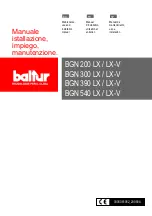
441 01 2314 06
Specifications are subject to change without notice.
17
8. Electrical Wiring
ELECTRICAL SHOCK HAZARD
Failure to follow this warning could result in
personal injury or death.
Turn OFF electrical power at fuse box or service
panel, lockout and tag with a suitable warning label,
before making any electrical connections and
ensure a proper ground connection is made before
connecting line voltage.
!
WARNING
Power Supply Wiring
The furnace
MUST
be electrically wired and grounded in accor-
dance with local codes, or in the absence of local codes, with the
National Electrical Code (NEC), ANSI/NFPA 70
−
2005 in the U.S.,
or the Canadian Electrical Code (CEC), CSA C22.1 in Canada.
The power supply to the furnace connections must be between
104 VAC and 127 VAC during furnace operation for acceptable
performance.
Field wiring connections must be made inside the furnace connec-
tion box. A suitable strain relief should be used at the point the
wires exit the furnace casing.
Copper conductors shall be used.
Line voltage wires should
conform to temperature limitation of 35
°
C rise. Wire and circuit
breaker sizing shall be based on the ampacity of the furnace elec-
trical components plus the amps for all installed accessories (1.0
amps total for EAC and HUM). Ampacity can be determined by us-
ing the NEC or CEC.
NOTE: Furnace will not have normal operation is line polarity is re-
versed. Check ALL field and control connections prior to opera-
tion.
Furnace must be installed so the electrical components are pro-
tected from water and connected to its own separate circuit.
Junction Box (J-Box) Relocation
The J
−
Box is installed on left side of casing. An alternate J
−
Box
location on right side can be used.
1. Remove bag containing two hole plugs and two self
−
tapping
screws from loose parts bag in blower compartment.
2. Remove and discard two screws holding J
−
Box to casing.
3. Move large hole plug from right to left J
−
Box location.
4. Move J
−
Box to alternate location and attach using two self
−
tapping screws from bag.
5. A wire tie may need to be cut for additional wire length.
6. Apply two hole plugs from bag at left J
−
Box location.
7. Position all wires away from sharp edges and moving parts.
Do not pinch J
−
Box or other wires when reinstalling blower
compartment door.
Thermostat
Thermostat location has an important effect on the operation of the
furnace. Follow instructions included with thermostat for correct
mounting and wiring.
Low voltage connections to furnace must be made on terminal
board of furnace control. (See
Figure 11
)
If cooling is used, the
Y
from the thermostat must be connected to
the control
Y
to energize cooling blower speed.
When using a nonelectronic thermostat, the thermostat heat anti-
cipator must be set to match the amp draw of the electrical com-
ponents in R
−
W circuit. Accurate amp draw readings can be
obtained at thermostat subbase terminals R and W. For an elec-
tronic thermostat, set cycle rate for 3 cycles per hour.
Measure heat anticipator current in series from R to W at the ther-
mostat. If 24VAC humidifier is wired up to control, humidifier must
be energized. Allow furnace to operate for two minutes before re-
cording the AC amperage reading. Set anticipator on thermostat
to recorded value.
Optional Equipment
All wiring from furnace to optional equipment
MUST
conform to lo-
cal codes or, in the absence of local codes, the applicable national
codes. Install wiring in accordance with manufacturer’s instruc-
tions.
Humidifier/Electronic Air Cleaner
The furnace is wired for humidifier and/or electronic air cleaner
connection.
!
REDUCED FURNACE LIFE HAZARD
Failure to follow this caution may result in reduced
furnace life.
Do NOT exceed 115V/1.0 amp. maximum current
load for both the EAC terminal and the HUM
terminal combined.
CAUTION
HUMIDIFIER
−
The HUM (115VAC) is energized when the
pressure switch closes on a call for heat. The HUM is ener-
gized when the inducer is energized.
ELECTRONIC AIR CLEANER
−
EAC is energized when there
is a blower speed call, except is NOT energized when blower
operates in the hard
−
wired continuous fan mode.
















































